The glass table bacteria tank market is set to grow from USD 338.9 million in 2025 to USD 903.3 million by 2035, with a CAGR of 10.3%. The initial phase, from 2025 to 2030, shows steady growth, with the market expanding from USD 338.9 million to USD 553.3 million. This increase is driven by the rising demand for advanced, environmentally-friendly glass tanks in various sectors, including laboratory research, biotechnology, and industrial applications. The market’s growth contribution index during this period is primarily attributed to the increasing adoption of glass tanks that offer better resistance to bacteria, durability, and ease of maintenance.
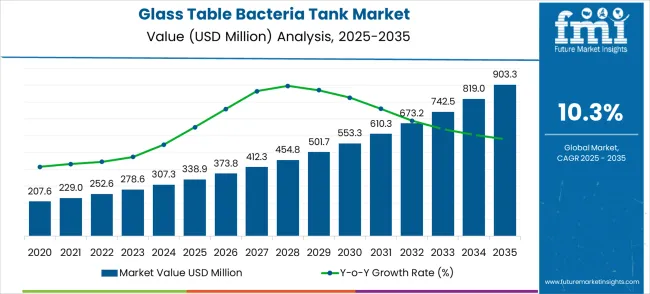
Between 2030 and 2035, the market continues to experience significant growth, moving from USD 553.3 million to USD 903.3 million. This period sees a rapid acceleration in demand, particularly driven by technological advancements in glass manufacturing, increased focus on health and safety standards, and regulatory push for cleaner environments. The market's growth contribution during these years is heavily influenced by broader industrial and scientific use, as well as innovation in tank design and functionality. The growing awareness of health risks linked to bacteria contamination in various environments fuels demand for glass tanks, helping the market maintain strong momentum toward its projected peak in 2035.
| Metric | Value |
|---|---|
| Estimated Value in (2025E) | USD 338.9 million |
| Forecast Value in (2035F) | USD 903.3 million |
| Forecast CAGR (2025 to 2035) | 10.3% |
The glass table bacteria tank market holds a niche but growing share within its parent markets. In the laboratory equipment market, glass table bacteria tanks account for about 3-5% of the total market. Their primary function in microbiological research drives this share, particularly in research labs and academic settings. Within the biotechnology market, the tanks represent approximately 2-4%, as they are key tools for microbial culture studies and bioprocessing applications. The environmental monitoring market sees the glass table bacteria tank holding about 1-3%, used for research on bacterial behavior in environmental studies. In the medical equipment market, glass table bacteria tanks contribute around 2-4%, as microbiology labs use them to cultivate and study bacteria for diagnostics and pharmaceutical development. In the aquarium and fish tank market, these tanks represent about 1-2%, used mainly for research on bacterial ecosystems in water environments.
Market expansion is being supported by the exceptional chemical resistance properties of glass materials and their ability to provide optimal cultivation environments for sensitive microbiological research applications. Modern biotechnology laboratories are increasingly focused on cultivation systems that can maintain sterile conditions while providing excellent optical clarity for observation and monitoring of bacterial growth. The proven capability of glass bacteria tanks to deliver superior chemical inertness, thermal stability, and ease of sterilization makes them essential components of advanced microbiology laboratory equipment.
The growing emphasis on biopharmaceutical development and personalized medicine research is driving demand for high-quality laboratory equipment that can support complex cultivation protocols and maintain sample integrity. Industry preference for cultivation systems that combine reliability with ease of use and cleaning is creating opportunities for advanced glass bacteria tank development. The rising influence of quality assurance requirements and regulatory compliance standards is also contributing to increased demand for laboratory-grade glass equipment across different research institutions and biotechnology companies.
The market is segmented by classification, application, and region. By classification, the market is divided into ordinary glass bacteria jar, reactive glass bacteria jar, and others. Based on application, the market is categorized into biopharmaceuticals, scientific research, food, and others. Regionally, the market is divided into Asia Pacific, North America, Europe, Latin America, and Middle East & Africa.
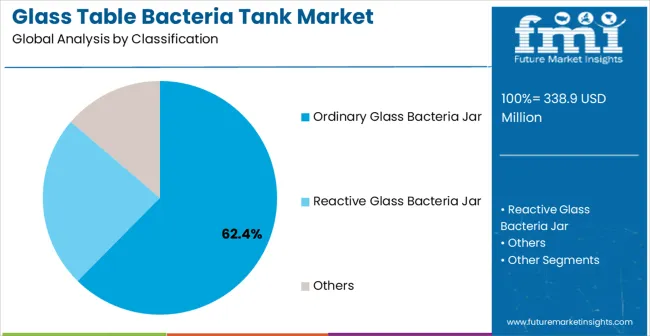
The ordinary glass bacteria jar classification is projected to account for 62.4% of the glass table bacteria tank market in 2025, reaffirming its position as the category's dominant product type. Laboratory professionals increasingly recognize the optimal balance of performance, cost-effectiveness, and versatility provided by ordinary glass formulations for most standard microbiology applications. This classification addresses the majority of current bacterial cultivation requirements while providing essential chemical resistance and optical clarity characteristics.
This classification forms the foundation of most microbiology laboratory setups, as it represents the most established and widely adopted approach for bacterial cultivation equipment. Manufacturing experience and application development continue to strengthen confidence in ordinary glass bacteria jar performance. With increasing recognition of the need for reliable and cost-effective cultivation solutions, ordinary glass formulations align with both current laboratory requirements and budget considerations. Their broad compatibility across multiple applications ensures market dominance, making them the central growth driver of glass bacteria tank adoption.
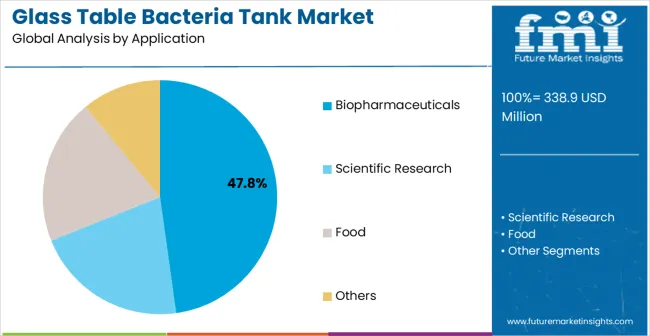
Biopharmaceuticals are projected to represent 47.8% of glass table bacteria tank demand in 2025, underscoring their role as the primary application driving market development. Pharmaceutical companies recognize that biopharmaceutical research and development requires the highest quality and most reliable cultivation equipment to ensure accurate results and regulatory compliance. Biopharmaceutical applications demand exceptional sterility maintenance and chemical inertness that glass bacteria tanks are uniquely positioned to deliver.
The segment is supported by the continuous expansion of drug discovery programs requiring sophisticated cultivation capabilities and the growing deployment of biotechnology applications across pharmaceutical research. Biopharmaceutical companies are increasingly adopting advanced laboratory equipment that can support complex research protocols while maintaining strict quality standards. As understanding of biopharmaceutical development requirements advances, glass bacteria tank applications will continue to serve as the primary commercial driver, reinforcing their essential position within the laboratory equipment market.
The glass table bacteria tank market is advancing steadily due to increasing investment in biotechnology research and growing demand for high-quality laboratory equipment. The market faces challenges including competition from alternative materials, fragility concerns in laboratory environments, and requirements for specialized handling procedures. Innovation in glass formulation and surface treatment technologies continue to influence product development and market expansion patterns.
The growing investment in biotechnology research is enabling more sophisticated glass bacteria tank applications with enhanced cultivation and monitoring capabilities. Advanced laboratory platforms offer comprehensive automation features, including temperature control and environmental monitoring, that are particularly important for modern microbiology research. Automated systems provide access to precise cultivation control that can optimize bacterial growth conditions and research outcomes.
Modern laboratory equipment companies are incorporating specialized glass formulations, anti-contamination coatings, and surface modification technologies to enhance glass bacteria tank performance and durability. These technologies improve chemical resistance, enable better cleaning characteristics, and provide enhanced optical clarity throughout extended use cycles. Advanced glass integration also enables optimized thermal shock resistance and improved compatibility with sterilization procedures.

| Country | CAGR (2025-2035) |
|---|---|
| China | 13.9% |
| India | 12.9% |
| Germany | 11.8% |
| Brazil | 10.8% |
| U.S. | 9.8% |
| U.K. | 8.8% |
| Japan | 7.7% |
The glass table bacteria tank market is experiencing robust growth globally, with China leading at a 13.9% CAGR through 2035, driven by massive investment in biotechnology research, government support for pharmaceutical development, and rapidly expanding laboratory infrastructure. India follows at 12.9%, supported by growing pharmaceutical manufacturing sector, increasing investment in scientific research, and expanding biotechnology capabilities. Germany shows growth at 11.8%, emphasizing precision manufacturing excellence and comprehensive laboratory equipment standards. Brazil records 10.8% growth, focusing on expanding pharmaceutical research and growing investment in biotechnology applications. The U.S. shows 9.8% growth, representing steady demand from established research institutions and biotechnology companies.
The report covers an in-depth analysis of 40+ countries with top-performing countries highlighted below.
The glass table bacteria tanks market in China is expected to experience remarkable growth at a CAGR of 13.9% through 2035, driven by unprecedented investment in biotechnology research and comprehensive government support for pharmaceutical industry development. The country's rapidly expanding research infrastructure and increasing capabilities in life sciences research are creating substantial opportunities for advanced laboratory equipment adoption. Major domestic and international laboratory equipment companies are establishing comprehensive manufacturing and distribution facilities to serve the growing research market.
Revenue from glass table bacteria tanks in India is expanding at a CAGR of 12.9%, supported by rapidly growing pharmaceutical manufacturing sector, increasing investment in research and development, and expanding biotechnology research capabilities. The country's substantial pharmaceutical industry base and commitment to research excellence are driving demand for high-quality laboratory equipment. International laboratory equipment companies and domestic manufacturers are establishing partnerships to serve the growing demand for scientific equipment.
Demand for glass table bacteria tanks in Germany is forecasted to rise at a CAGR of 11.8%, supported by the country's leadership in precision manufacturing and comprehensive expertise in laboratory equipment technologies. German research institutions and biotechnology companies consistently invest in high-quality laboratory equipment and advanced research capabilities. The market is characterized by technical excellence, comprehensive quality standards, and established relationships between research organizations and equipment suppliers.
In Brazil, glass table bacteria tanks are expected to grow at a CAGR of 10.8 % through 2035, driven by expanding pharmaceutical research sector, increasing investment in biotechnology applications, and growing focus on scientific research capability development. Brazilian research institutions and pharmaceutical companies are increasingly adopting advanced laboratory equipment to support research excellence and innovation.
Future Trends in Glass Table Bacteria Tank Market in the US

Glass table bacteria tanks market in the USA is anticipated to expand at a CAGR of 9.8%, supported by established biotechnology research infrastructure, continued innovation in pharmaceutical development, and comprehensive laboratory equipment utilization. American research institutions and biotechnology companies maintain consistent adoption of high-quality laboratory equipment through established procurement relationships and research excellence standards.
Glass Table Bacteria Tank Market Outlook in the UK
The glass table bacteria tanks market in the UK expected to grow steadily at a CAGR of 8.8% through 2035, supported by scientific research excellence initiatives and established biotechnology research capabilities. British research institutions emphasize high-quality laboratory equipment within comprehensive research frameworks that prioritize scientific rigor and experimental reliability.
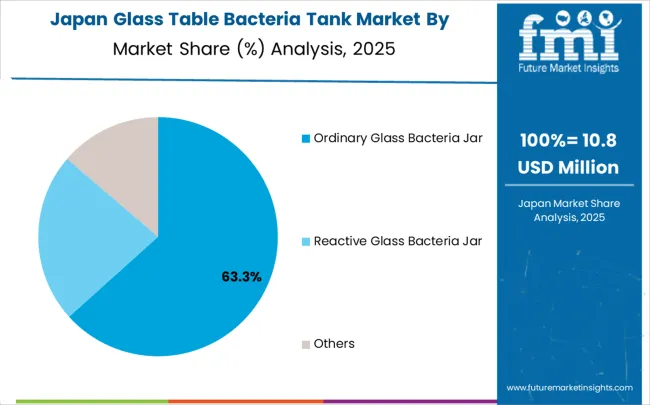
In Japan, glass table bacteria tanks market is projected to grow at a CAGR of 7.7% through 2035, supported by the country's leadership in precision manufacturing and comprehensive approach to scientific research equipment. Japanese research institutions and biotechnology companies emphasize quality-driven adoption of laboratory equipment within established frameworks that prioritize technical excellence and research reliability.
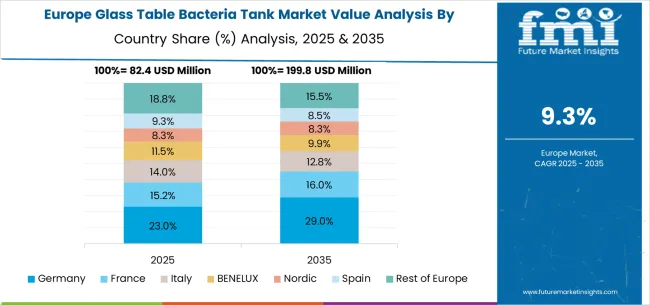
The glass table bacteria tank market in Europe is projected to expand steadily through 2035, supported by increasing investment in biotechnology research, rising demand for pharmaceutical development, and ongoing focus on laboratory equipment quality standards. Germany will continue to lead the regional market, accounting for 31.7% in 2025 and rising to 32.4% by 2035, supported by strong pharmaceutical industry integration, advanced research capabilities, and comprehensive laboratory equipment standards. The United Kingdom follows with 19.2% in 2025, maintaining 19.4% by 2035, driven by scientific research excellence initiatives, established biotechnology sector, and consistent demand patterns.
France holds 16.8% in 2025, edging up to 17.1% by 2035 as research institutions expand biotechnology capabilities and demand grows for high-quality laboratory equipment. Italy contributes 12.5% in 2025, remaining stable at 12.7% by 2035, supported by pharmaceutical research growth and increasing adoption of advanced laboratory equipment. Spain represents 9.1% in 2025, moving upward to 9.3% by 2035, underpinned by expanding research infrastructure and increasing investment in biotechnology applications.
Nordic countries together account for 6.4% in 2025, maintaining their position at 6.5% by 2035, supported by advanced research initiatives and consistent demand from established research institutions. The Rest of Europe represents 4.3% in 2025, declining slightly to 2.6% by 2035, as larger markets capture greater focus and established research infrastructure advantages.
The glass table bacteria tank market is characterized by competition among established glass manufacturing companies, specialized laboratory equipment providers, and innovative scientific glassware manufacturers. Companies are investing in advanced glass formulation technologies, quality control systems, strategic partnerships, and market development to deliver high-performance, reliable, and compliant laboratory glassware solutions. Technology development, quality assurance, and customer relationship strategies are central to strengthening competitive advantages and market presence.
Schott AG leads the market with significant expertise in specialty glass manufacturing and laboratory equipment development, offering comprehensive glass bacteria tank solutions with focus on quality optimization and application versatility. Corning provides established glass technology capabilities with emphasis on advanced materials and scientific applications. DWK Life Sciences focuses on comprehensive laboratory glassware manufacturing with global reach and diverse application expertise. Borosil delivers established glass manufacturing capabilities with strong focus on laboratory and scientific applications.
Asahi Kasei operates with focus on advanced materials development and comprehensive chemical resistance capabilities. Bellco Glass specializes in laboratory glassware manufacturing with emphasis on biotechnology and research applications. VITLAB provides comprehensive laboratory equipment solutions with focus on European markets. Eppendorf leverages laboratory equipment expertise to provide integrated solutions. Suzhou Womei Biology focuses on domestic market development with specialized biotechnology applications, providing regional market access and cost-effective solutions to enhance overall market accessibility.
| Items | Values |
|---|---|
| Quantitative Units (2025) | USD 338.9 million |
| Classification | Ordinary Glass Bacteria Jar, Reactive Glass Bacteria Jar, Others |
| Application | Biopharmaceuticals, Scientific Research, Food, Others |
| Regions Covered | Asia Pacific, North America, Europe, Latin America, Middle East & Africa |
| Countries Covered | China, India, Germany, Brazil, United States, United Kingdom, Japan and 40+ countries |
| Key Companies Profiled | Schott AG, Corning, DWK Life Sciences, Borosil, Asahi Kasei, Bellco Glass, VITLAB, Eppendorf, Suzhou Womei Biology |
| Additional Attributes | Dollar sales by product type and application, regional adoption trends, competitive landscape, research institution partnerships, integration with laboratory automation systems, innovations in glass formulation and surface treatments, quality control analysis, and sterilization compatibility optimization strategies |
The global glass table bacteria tank market is estimated to be valued at USD 338.9 million in 2025.
The market size for the glass table bacteria tank market is projected to reach USD 903.3 million by 2035.
The glass table bacteria tank market is expected to grow at a 10.3% CAGR between 2025 and 2035.
The key product types in glass table bacteria tank market are ordinary glass bacteria jar, reactive glass bacteria jar and others.
In terms of application, biopharmaceuticals segment to command 47.8% share in the glass table bacteria tank market in 2025.






Our Research Products

The "Full Research Suite" delivers actionable market intel, deep dives on markets or technologies, so clients act faster, cut risk, and unlock growth.

The Leaderboard benchmarks and ranks top vendors, classifying them as Established Leaders, Leading Challengers, or Disruptors & Challengers.

Locates where complements amplify value and substitutes erode it, forecasting net impact by horizon

We deliver granular, decision-grade intel: market sizing, 5-year forecasts, pricing, adoption, usage, revenue, and operational KPIs—plus competitor tracking, regulation, and value chains—across 60 countries broadly.

Spot the shifts before they hit your P&L. We track inflection points, adoption curves, pricing moves, and ecosystem plays to show where demand is heading, why it is changing, and what to do next across high-growth markets and disruptive tech

Real-time reads of user behavior. We track shifting priorities, perceptions of today’s and next-gen services, and provider experience, then pace how fast tech moves from trial to adoption, blending buyer, consumer, and channel inputs with social signals (#WhySwitch, #UX).

Partner with our analyst team to build a custom report designed around your business priorities. From analysing market trends to assessing competitors or crafting bespoke datasets, we tailor insights to your needs.
Supplier Intelligence
Discovery & Profiling
Capacity & Footprint
Performance & Risk
Compliance & Governance
Commercial Readiness
Who Supplies Whom
Scorecards & Shortlists
Playbooks & Docs
Category Intelligence
Definition & Scope
Demand & Use Cases
Cost Drivers
Market Structure
Supply Chain Map
Trade & Policy
Operating Norms
Deliverables
Buyer Intelligence
Account Basics
Spend & Scope
Procurement Model
Vendor Requirements
Terms & Policies
Entry Strategy
Pain Points & Triggers
Outputs
Pricing Analysis
Benchmarks
Trends
Should-Cost
Indexation
Landed Cost
Commercial Terms
Deliverables
Brand Analysis
Positioning & Value Prop
Share & Presence
Customer Evidence
Go-to-Market
Digital & Reputation
Compliance & Trust
KPIs & Gaps
Outputs
Full Research Suite comprises of:
Market outlook & trends analysis
Interviews & case studies
Strategic recommendations
Vendor profiles & capabilities analysis
5-year forecasts
8 regions and 60+ country-level data splits
Market segment data splits
12 months of continuous data updates
DELIVERED AS:
PDF EXCEL ONLINE
Glass Rolling Forming Machine Market Size and Share Forecast Outlook 2025 to 2035
Glass Liquor Bottle Market Size and Share Forecast Outlook 2025 to 2035
Glass Bottles Market Forecast and Outlook 2025 to 2035
Glass Laser Engraving Machine Market Size and Share Forecast Outlook 2025 to 2035
Glass Restoration Kit Market Size and Share Forecast Outlook 2025 to 2035
Glass Bottle and Container Market Forecast and Outlook 2025 to 2035
Glass Additive Market Forecast and Outlook 2025 to 2035
Glass Reactor Market Size and Share Forecast Outlook 2025 to 2035
Glass Cosmetic Bottle Market Size and Share Forecast Outlook 2025 to 2035
Glass & Metal Cleaner Market Size and Share Forecast Outlook 2025 to 2035
Glass Product Market Size and Share Forecast Outlook 2025 to 2035
Glassine Paper Market Size and Share Forecast Outlook 2025 to 2035
Glass Container Market Size and Share Forecast Outlook 2025 to 2035
Glass Fibre Yarn Market Size and Share Forecast Outlook 2025 to 2035
Glass Cloth Electrical Insulation Tape Market Size and Share Forecast Outlook 2025 to 2035
Glass Bonding Adhesive Market Size and Share Forecast Outlook 2025 to 2035
Glass Mat Thermoplastic Market Size and Share Forecast Outlook 2025 to 2035
Glassine Paper Industry Analysis in Western Europe Size and Share Forecast Outlook 2025 to 2035
Glassine Paper Industry Analysis in Korea Size and Share Forecast Outlook 2025 to 2035
Glassine Paper Industry Analysis in Japan Size and Share Forecast Outlook 2025 to 2035

Thank you!
You will receive an email from our Business Development Manager. Please be sure to check your SPAM/JUNK folder too.
Chat With
MaRIA